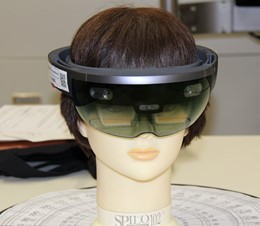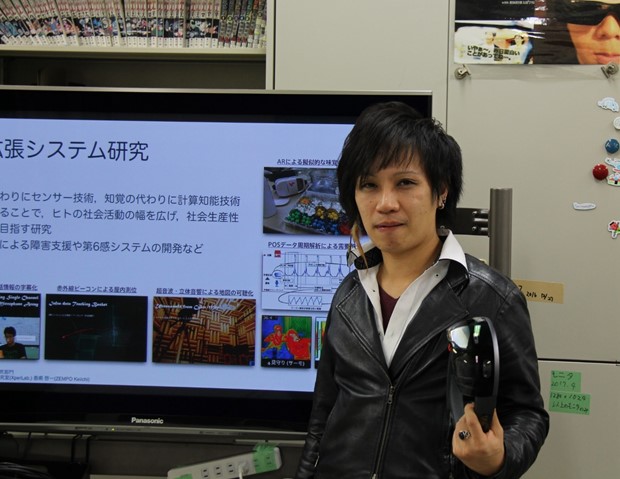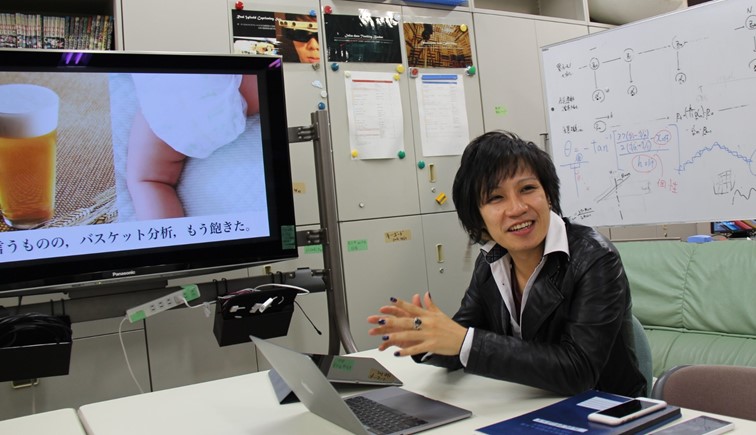TSUKUBA FUTURE
#093 The Keyphrase is Conversion of Information
Assistant Professor ZEMPO Keiichi, Faculty of Engineering, Information and Systems

One may not quite know what to think upon hearing the phrase "intelligence augmentation system." Humans perceive the world through five senses, and acquire all manner of information. An intelligence augmentation system uses technology to complement the five senses, in an attempt to expand the methods by which we may perceive the world. Should this be realized, it may no longer be necessary to go to the trouble to learn foreign languages. Great expectations are being placed on such near-future technology.

You may have heard the term augmented reality, or AR. If for example you were told that the Pokemon GO game is one example of AR, it might come into focus. By superposing virtual images on the actual scenery that appears through a smartphone camera, reality is augmented with a fictitious world. On the other hand, in virtual reality, or VR, a fictitious image is deployed before one's eyes. That is, whereas in virtual reality a pseudo-experience is supplied, what augmented reality supplies is a supplemented or augmented version of the actual world.
Prof. Zempo, who is conducting research on the application of augmented reality, further expands this concept to what he calls intelligence augmentation systems. He likes to compare this to a situation in which the Olympic athlete, the Paralympic athlete, and the cyborgs are all combined. If technology is used to complement the limited abilities or augment the disabilities of an individual, the possibilities of the individual will expand. For example, a person with a hearing disability could be provided with a head-mounted display through special goggles, which instantaneously convert the words spoken by another person into text information that is displayed as speech balloon. Or, a person with a vision impairment might be supplied with map information by auditory means, using stereophonic sound and ultrasound. Stereophonic sound is a technology that imparts a sense of the direction of the sound source angle. Using this, a small number of super-directive speakers can be controlled to supply omnidirectional information required only to those who need it, without requiring the installation of speakers at station ticket gates, restroom entrances, or the like. It might be called a technique for creating the perceptual illusion of the position of a sound source.
Intentionally creating such an illusion is expressed by Prof. Zempo as "hacking" perceptual information. External physical information is converted to cause the individual to sense it. Converting the perceptual information mentioned above into audio information is also an example, and in this field of research, there has also been "hacking" of the sense of taste. If the color of a food could be changed in a head-mounted display such that the individual could perceive the flavor of, say, a snow cone as a color, it would be possible to guard against too much salt intake, for example.
Prof. Zempo has also been augmenting his own areas of interest since studying at the University of Tsukuba. From research on radio telescopes in his undergraduate days, he switched to studying management in the master's degree course of the graduate school, and for the PhD course transitioned once again to research on acoustic signal processing. As a postdoctoral researcher, he did research in service engineering. With his innate love of gadgets and his self-admitted penchant for prominently shifting from one field to another, Prof. Zempo has simultaneously engaged in a number of interdisciplinary researches that span conventional field boundaries, espousing a broad-but-shallow creed. In his graduate school days he planned a lecture subject for graduate students titled "Professors Presentation Battle" and exhibited considerable initiative in appealing directly to the dean to have it adopted.
He is also currently undertaking experimental studies at service sites, utilizing the knowledge of his master's degree in management. Infrared beacons are installed in the shopping baskets of supermarkets, and flow lines of customers are recorded by receivers that measure the angles of the beacons, while simultaneously collecting information on purchased merchandise as part of "big data" acquisition. Put this way, they sound like complicated devices, but Prof. Zempo succeeded in achieving low cost and high precision. An aim is to offer pinpointed services to all customers. In addition to merchandise preferences and shelf arrangement, if combined with a sensory augmentation device, it may be possible to have the product that a customer is looking for call out to the customer, or to have persons who speak different languages shop for goods while freely conversing. Prof. Zempo likens such possibilities to a world in which AI fills all space, like the ether.
If information is equalized through sensory augmentation, possibilities will be expanded through the seamless connection of the cyber space and the physical space. If physical barriers (the five senses) can be overcome by supplementing signals, social relationships and modes of work will change. Prof. Zempo makes free use of enthusiastic phrases. Aha, so if we leave everything to AI and other technologies instead, we'll have that much spare time, and in such a future society individual humans can enjoy their own creative pursuits. He has a fervent desire to study the kind of "seamless-optimized new world" that this could bring about. During the interview with Prof. Zempo, his smartphone beeped. It appears that a restaurant for which he had made an online reservation was calling for confirmation. His "new world" is still a long way off.

Holding a head-mounted display.

His presentations, which unfurl a wide variety of phraseology ranging from cyber-terminology to marketing terms, are well received.
Article by Science Communicator at the Office of Public Relations


